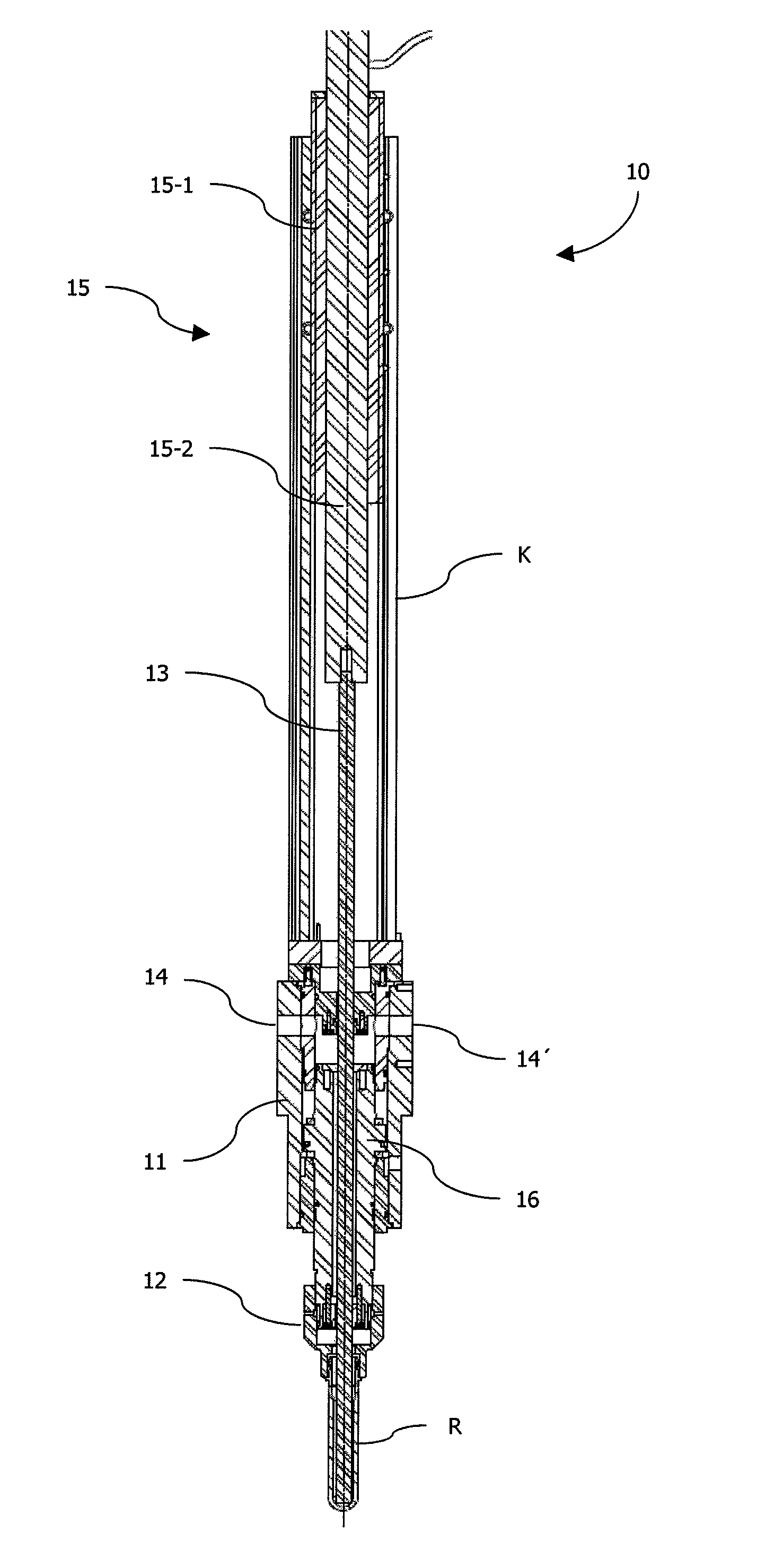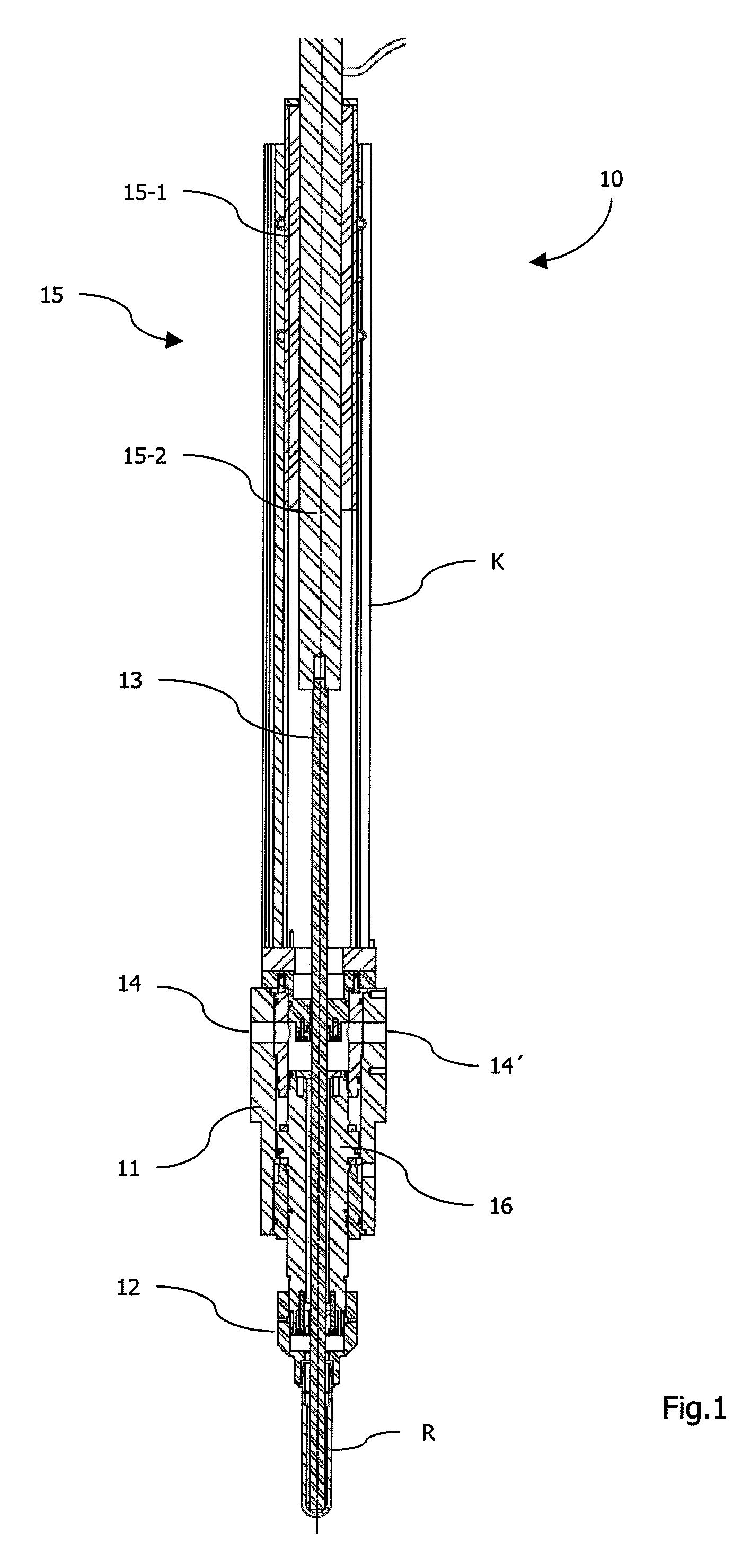Devices and method for draw blow moulding a container and the corresponding use
a technology of blow molding and containers, applied in the field of devices for blow molding containers, can solve the problems of rotary motion, increase of the weight of the already high device, and not only of the enormous installation height of the blow molding device, so as to achieve the effect of cost-effective production and easy production
- Summary
- Abstract
- Description
- Claims
- Application Information
AI Technical Summary
Benefits of technology
Problems solved by technology
Method used
Image
Examples
embodiment 10
[0040]FIG. 1 shows a first compact embodiment 10 of a device according to the invention for blow molding containers from parisons R. The device 10 includes a blowing cylinder 11 and a blowing nozzle 12 mounted thereon, in which the parison R is accommodated. A stretching rod 13 can be passed through the nozzle 12 into the parison R and out of it again and is enclosed by the cylinder 11. Compressed air is supplied to the nozzle 12 via openings 14, 14′ in the cylinder 11, so as to blow up the parison R simultaneously or time-delayed to the stretching process against a hollow mold (not illustrated). The stretching rod 13 is driven via a tubular electric linear motor 15, the armature 15-2 of which is screwed to the stretching rod 13. Alternative connections, however, can also provide for a quick closure or a coupling. A quick replacement of the stretching rod 13 is thus possible as a function of the container production. The stator 15-1 of the motor 15 is accommodated in a housing, whic...
embodiment 20
[0042]FIG. 2 shows a second, even more compact embodiment 20 of a device according to the invention. Contrary to the device 10 of FIG. 1, a blowing cylinder 21 as well as a blowing piston 26 supported therein is adapted to an armature 25-2 of a tubular electric linear motor 25 such that this armature 25-2 may be passed into the cylinder shortly in front of the parison R in one stroke movement (of approximately 400 mm). In the area of a free end, the piston 26 encompasses openings 24, 24′, which converge at right angles to a nozzle 22 mounted at this end and to which compressed air is supplied via corresponding openings in the cylinder 21. Compared to the device 10, this construction allows for a further shortening of the device 20 and reinforces the advantages already mentioned therein. As is already described in FIG. 1, a stretching rod 23 is thereby screwed to the armature 25-2 of the motor 25, so as to ensure a rapid replacement as a function of the container production. As a fun...
embodiment 40
[0044]FIG. 4 shows a fourth, even more compact embodiment 40 of a device according to the invention. A further shortening of the design thereof is attained in that the armature 45-2 of a tubular electric linear motor 45 is embodied as part of a stretching rod 43. A constructive adaptation of the entire head of the device as in FIGS. 2 and 3 is thus not necessary. A blowing cylinder 41 including openings 44, 44′, a blowing piston 46 and a blowing nozzle 42 can be removed from the device of FIG. 1 in an unchanged manner. The motor 45 including stator 45-1 can thus be arranged directly above the cylinder 41, because the motion of its armature 45-2, namely the stretching rod 43 herein, is not limited by the maximal depth of the cylinder 41.
[0045]Finally, FIG. 5 shows a fifth, even further compressed embodiment 50 of a device according to the invention. As is already shown in FIG. 4, the armature 55-2 of a tubular electric linear motor 55 is embodied as part of a stretching rod 53, thus ...
PUM
| Property | Measurement | Unit |
|---|---|---|
| stroke height | aaaaa | aaaaa |
| height | aaaaa | aaaaa |
| distance | aaaaa | aaaaa |
Abstract
Description
Claims
Application Information
 Login to View More
Login to View More - R&D
- Intellectual Property
- Life Sciences
- Materials
- Tech Scout
- Unparalleled Data Quality
- Higher Quality Content
- 60% Fewer Hallucinations
Browse by: Latest US Patents, China's latest patents, Technical Efficacy Thesaurus, Application Domain, Technology Topic, Popular Technical Reports.
© 2025 PatSnap. All rights reserved.Legal|Privacy policy|Modern Slavery Act Transparency Statement|Sitemap|About US| Contact US: help@patsnap.com



